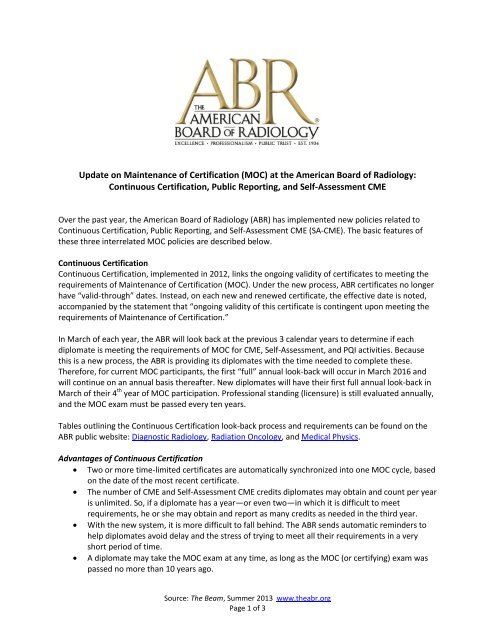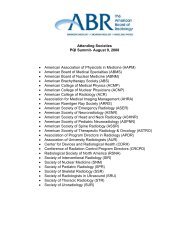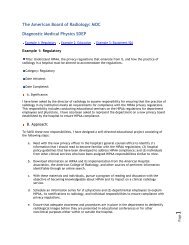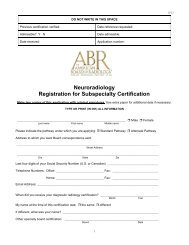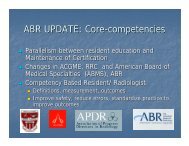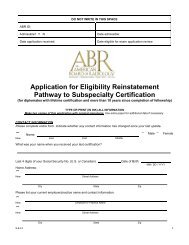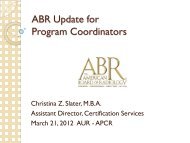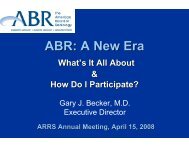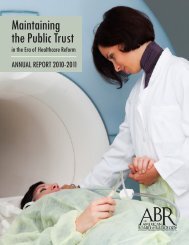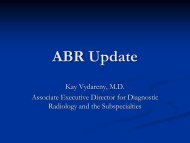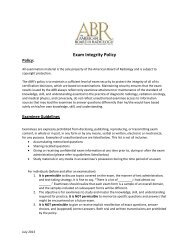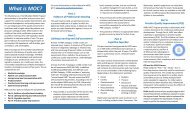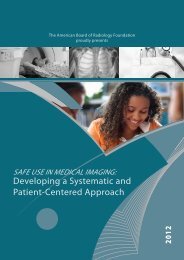MOC Update - The American Board of Radiology
MOC Update - The American Board of Radiology
MOC Update - The American Board of Radiology
You also want an ePaper? Increase the reach of your titles
YUMPU automatically turns print PDFs into web optimized ePapers that Google loves.
<strong>Update</strong> on Maintenance <strong>of</strong> Certification (<strong>MOC</strong>) at the <strong>American</strong> <strong>Board</strong> <strong>of</strong> <strong>Radiology</strong>:<br />
Continuous Certification, Public Reporting, and Self-Assessment CME<br />
Over the past year, the <strong>American</strong> <strong>Board</strong> <strong>of</strong> <strong>Radiology</strong> (ABR) has implemented new policies related to<br />
Continuous Certification, Public Reporting, and Self-Assessment CME (SA-CME). <strong>The</strong> basic features <strong>of</strong><br />
these three interrelated <strong>MOC</strong> policies are described below.<br />
Continuous Certification<br />
Continuous Certification, implemented in 2012, links the ongoing validity <strong>of</strong> certificates to meeting the<br />
requirements <strong>of</strong> Maintenance <strong>of</strong> Certification (<strong>MOC</strong>). Under the new process, ABR certificates no longer<br />
have “valid-through” dates. Instead, on each new and renewed certificate, the effective date is noted,<br />
accompanied by the statement that “ongoing validity <strong>of</strong> this certificate is contingent upon meeting the<br />
requirements <strong>of</strong> Maintenance <strong>of</strong> Certification.”<br />
In March <strong>of</strong> each year, the ABR will look back at the previous 3 calendar years to determine if each<br />
diplomate is meeting the requirements <strong>of</strong> <strong>MOC</strong> for CME, Self-Assessment, and PQI activities. Because<br />
this is a new process, the ABR is providing its diplomates with the time needed to complete these.<br />
<strong>The</strong>refore, for current <strong>MOC</strong> participants, the first “full” annual look-back will occur in March 2016 and<br />
will continue on an annual basis thereafter. New diplomates will have their first full annual look-back in<br />
March <strong>of</strong> their 4 th year <strong>of</strong> <strong>MOC</strong> participation. Pr<strong>of</strong>essional standing (licensure) is still evaluated annually,<br />
and the <strong>MOC</strong> exam must be passed every ten years.<br />
Tables outlining the Continuous Certification look-back process and requirements can be found on the<br />
ABR public website: Diagnostic <strong>Radiology</strong>, Radiation Oncology, and Medical Physics.<br />
Advantages <strong>of</strong> Continuous Certification<br />
Two or more time-limited certificates are automatically synchronized into one <strong>MOC</strong> cycle, based<br />
on the date <strong>of</strong> the most recent certificate.<br />
<strong>The</strong> number <strong>of</strong> CME and Self-Assessment CME credits diplomates may obtain and count per year<br />
is unlimited. So, if a diplomate has a year—or even two—in which it is difficult to meet<br />
requirements, he or she may obtain and report as many credits as needed in the third year.<br />
With the new system, it is more difficult to fall behind. <strong>The</strong> ABR sends automatic reminders to<br />
help diplomates avoid delay and the stress <strong>of</strong> trying to meet all their requirements in a very<br />
short period <strong>of</strong> time.<br />
A diplomate may take the <strong>MOC</strong> exam at any time, as long as the <strong>MOC</strong> (or certifying) exam was<br />
passed no more than 10 years ago.<br />
Source: <strong>The</strong> Beam, Summer 2013 www.theabr.org<br />
Page 1 <strong>of</strong> 3
Frequently Asked Questions about Continuous Certification<br />
<br />
<br />
<br />
I completed CME, self-assessment, and PQI activities in 2012. Will these credits be counted<br />
Yes. <strong>MOC</strong> Part 2 activities completed in 2012 will count toward your first look-back in 2016.<br />
<strong>The</strong>refore, this one-time exception will include credits completed during 4 calendar years (2012-<br />
2015). Even though 4 years will be counted instead <strong>of</strong> three, you will need to complete only 3<br />
years’ worth <strong>of</strong> requirements.<br />
I took my <strong>MOC</strong> exam early. Will my 10-year exam requirement be reset No. If your certificate<br />
expires in 2012, 2013, or 2014, and you have already passed the <strong>MOC</strong> exam, the date <strong>of</strong> your<br />
exam passage will be attributed to the valid-through date <strong>of</strong> your 10-year certificate. <strong>The</strong> new<br />
certificate that is issued will not have a valid-through date.<br />
I have a 10-year certificate with a “valid-through” date. What happens if I don’t meet the new<br />
Continuous Certification requirements If you were previously in a 10-year cycle, the ABR will<br />
honor your certificate through the “valid-through” date listed, irrespective <strong>of</strong> your <strong>MOC</strong> activity.<br />
(For more information concerning the implications on publicly reported <strong>MOC</strong> status, see the<br />
frequently-asked questions below.)<br />
Public Reporting <strong>of</strong> Diplomate Status<br />
In addition to the compelling pr<strong>of</strong>essional reasons, keeping current with <strong>MOC</strong> requirements is important<br />
because in March 2013, the <strong>American</strong> <strong>Board</strong> <strong>of</strong> Medical Specialties (ABMS) began reporting on its public<br />
website (www.certificationmatters.org) whether or not each ABR diplomate is meeting <strong>MOC</strong><br />
requirements for each certificate held. <strong>The</strong> three public reporting categories that may be attributed to<br />
each diplomate listed on the ABMS website are:<br />
<br />
<br />
<br />
Meeting the requirements <strong>of</strong> Maintenance <strong>of</strong> Certification<br />
Not meeting the requirements <strong>of</strong> Maintenance <strong>of</strong> Certification<br />
Not required to participate in Maintenance <strong>of</strong> Certification (for lifetime-certified diplomates.)<br />
<strong>The</strong> ABMS website also refers users to the ABR website (www.theabr.org), where further information<br />
regarding certification status can be found. <strong>The</strong> ABR’s website has been enhanced to include its own<br />
online verification database <strong>of</strong> ABR diplomates.<br />
Frequently-Asked Questions about Public Reporting<br />
<br />
<br />
What if I don’t meet my <strong>MOC</strong> requirements at the Continuous Certification look-back A builtin<br />
“catch-up” period <strong>of</strong> one year allows time to make up missing requirements while being<br />
classified as “certified, not meeting the requirements <strong>of</strong> Maintenance <strong>of</strong> Certification.” If you<br />
make up your requirements, you will again be reported as “meeting the requirements <strong>of</strong><br />
Maintenance <strong>of</strong> Certification.” If you have not met <strong>MOC</strong> requirements after the catch-up year,<br />
you will be reported as “certificate lapsed.”<br />
What if I have an older 10-year certificate with a “valid-through” date, but I don’t meet<br />
requirements under Continuous Certification If you continue not meeting <strong>MOC</strong> requirements<br />
at the annual Continuous Certification look-backs, you will be reported as “certified, not<br />
Source: <strong>The</strong> Beam, Summer 2013 www.theabr.org<br />
Page 2 <strong>of</strong> 3
meeting requirements <strong>of</strong> Maintenance <strong>of</strong> Certification” until your certificate expires. No<br />
diplomate with a valid certificate will be reported as “certificate lapsed.”<br />
<br />
What if I have a lifetime certificate, but I’m not enrolled in <strong>MOC</strong> You will be reported as “not<br />
required to participate in Maintenance <strong>of</strong> Certification.” If you decide to enroll, you will receive<br />
a “letter <strong>of</strong> <strong>MOC</strong> enrollment” as soon as you complete the application process, and you will then<br />
be reported on the ABMS and ABR websites as “meeting the requirements <strong>of</strong> Maintenance <strong>of</strong><br />
Certification.” When you meet the first three-year look-back requirements in March <strong>of</strong> your4 th<br />
year <strong>of</strong> <strong>MOC</strong> participation, you will be issued an <strong>MOC</strong> certificate. Your first look-back for the<br />
<strong>MOC</strong> exam will be in year 10 following enrollment. If at any look-back you fail to meet <strong>MOC</strong><br />
requirements, your public reporting status will revert to “not required to participate in<br />
Maintenance <strong>of</strong> Certification.”<br />
Broader acceptance <strong>of</strong> activities for <strong>MOC</strong> Part 2 (Self-Assessment CME)<br />
Beginning January 1, 2013, separate requirements for CME credits and self-assessment modules (SAMs)<br />
were merged into a single requirement: 75 CME credits every three years, at least 25 <strong>of</strong> which must be<br />
self-assessment CME (SA-CME) credits. At the same time, the definition <strong>of</strong> SA-CME was expanded to<br />
include more than just ABR-qualified SAMs. Now, the ABR also counts credits for completion <strong>of</strong> all AMA<br />
Category 1 CME activities in “enduring materials” (including web-based and print) and “journal-based<br />
CME” formats toward the <strong>MOC</strong> SA-CME requirement.<br />
AMA Category 1 CME activities performed in person or remotely, as in the case <strong>of</strong> teleconferences or<br />
“live” Internet activities, do NOT automatically count as self-assessment CME. For these types <strong>of</strong> CME<br />
activities to count as self-assessment CME credit, the organizations that create them must submit them<br />
for review and approval through the ABR qualification process. If accepted, these activities will be<br />
qualified by the ABR as SAMs and will count as self-assessment CME.<br />
More detailed information about SA-CME can be found on the ABR public website: Diagnostic <strong>Radiology</strong>,<br />
Radiation Oncology, and Medical Physics.<br />
Frequently-Asked Questions about Self-Assessment CME (SA-CME)<br />
<br />
<br />
<br />
Does this mean I have to complete 25 SAMs every three years No. You are required to<br />
complete at least 25 SA-CME credits every three years as part <strong>of</strong> your total requirement <strong>of</strong> 75<br />
Category 1 CME credits.<br />
What counts toward the 25 SA-CME credits SA-CME credits include 1) credits from completing<br />
ABR-qualified SAMs and/or 2) credits for completing AMA Category 1 CME activities in<br />
“enduring materials.”<br />
Why doesn’t the ABR count credits from teleconferences or “live” Internet activities as SA-CME<br />
credits According to AMA policy for CME, these activities may not include certain features that<br />
would qualify them for use as self-assessment tools. For more information on AMA CME<br />
policies, please click here.<br />
Any questions related to Continuous Certification, public reporting, or SA-CME requirements may be<br />
directed to the <strong>MOC</strong> Services Division at abrmocp@theabr.org, or (520) 519-2152.<br />
Source: <strong>The</strong> Beam, Summer 2013 www.theabr.org<br />
Page 3 <strong>of</strong> 3


